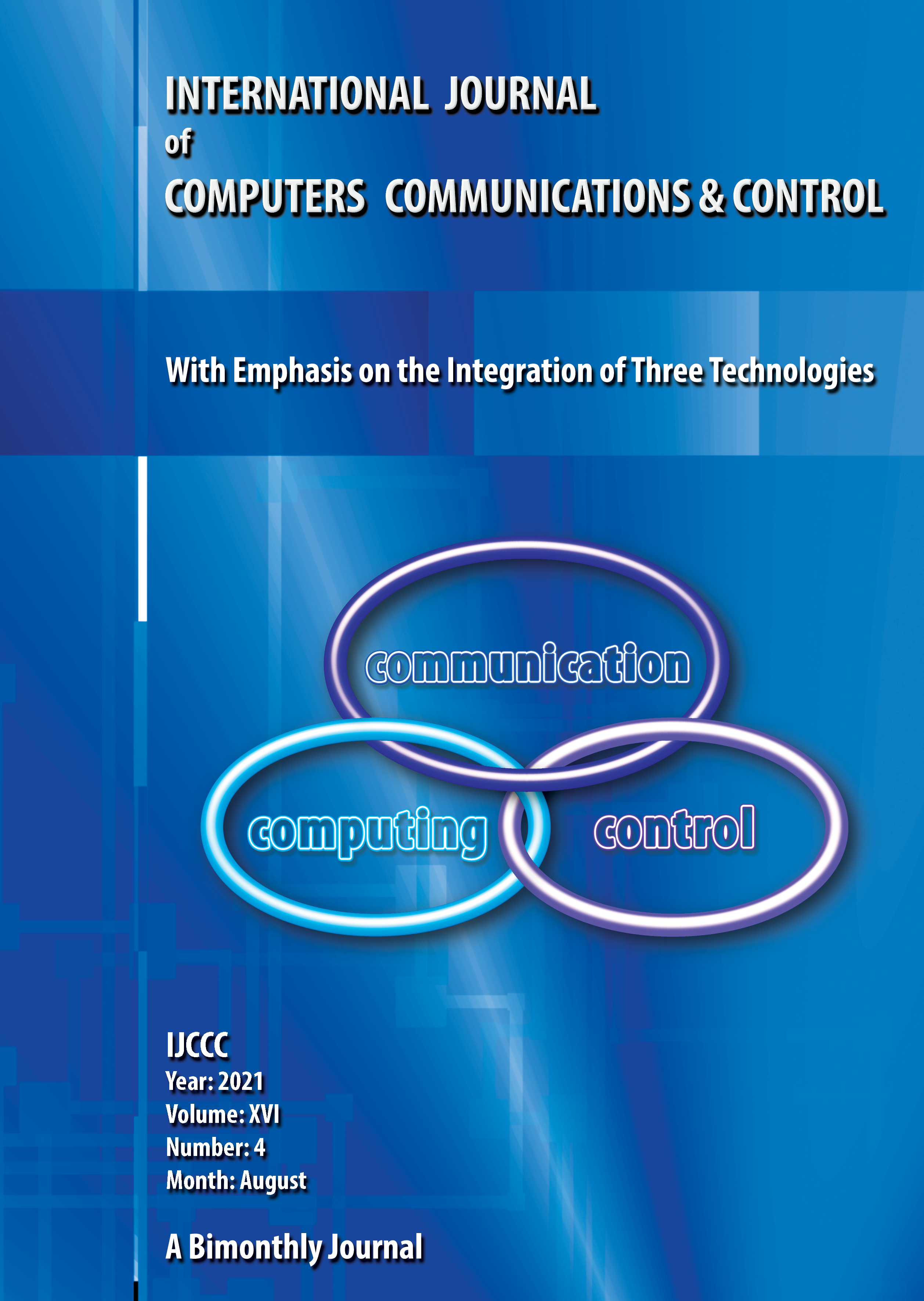The Modeling of Interval-Valued Time Series Using Possibility Measure-Based Encoding-Decoding Mechanism
Keywords:
interval-valued time series, granular computing, information granules, fuzzy sets, possibility measureAbstract
Interval-valued time series (ITS) is a collection of interval-valued data whose entires are ordered by time. The modeling of ITS is an ongoing issue pursued by many researchers. There are diverse ITS models showing better performance. This paper proposes a new ITS model using possibility measure-based encoding-decoding mechanism involved in fuzzy theory. The proposed model consists of four modules, say, linguistic variable generation module, encoding module, inference module and decoding module. The linguistic variable generation module can provide a series of linguistic variables expressed in fuzzy sets used to described dynamic characteristics of ITS. The encoding module encodes ITS into some embedding vectors with semantics with the aid of possibility measure and linguistic variables formed by linguistic variable generation module. The inference module uses artificial neural network to capture relationship implied in those embedding vectors with semantic. The decoding module decodes for the outputs of the inference module to produce the output of linguistic and interval formats by using the possibility measure-based encoding-decoding mechanism. In comparison with existing ITS models, the proposed model can not only produce the output of linguistic format, but also exhibit better numeric performance.
References
[2] Cohen, J. (1960). A coefficient of agreement for nominal scales, Educational and psychological measurement, 20(1), 37-46, 1960. https://doi.org/10.1177/001316446002000104
[3] Dubois, D.; Prade, H. (1998). Default reasoning and possibility theory, Artificial Intelligence, 35(2), 243-257, 1988. https://doi.org/10.1016/0004-3702(88)90014-8
[4] Dubois, D.; Prade, H. (2012). Possibility theory, In Computational complexity, Springer, 2240- 2252, 2012. https://doi.org/10.1007/978-1-4614-1800-9_139
[5] Gurney, K. (1997); An introduction to neural networks, CRC press. https://doi.org/10.4324/9780203451519
[6] Hansen, B.E. (2000). Sample splitting and threshold estimation, Econometrica, 68(3), 575-603, 2000. https://doi.org/10.1111/1468-0262.00124
[7] Holt, C.C. (2004). Forecasting seasonals and trends by exponentially weighted moving averages, International journal of forecasting, 20(1), 5-10, 2004. https://doi.org/10.1016/j.ijforecast.2003.09.015
[8] Lu W.; Zhou W.; Shan D.; Zhang L.Y.; Yang J.H.; Liu X.D. (2019). The linguistic modeling of interval-valued time series: A perspective of granular computing, Information Sciences, 478, 476-498, 2019. https://doi.org/10.1016/j.ins.2018.11.024
[9] Maia, A.L.S.; Carvalho, F.D.A.; Ludermir, T.B. (2008). Forecasting models for interval-valued time series, Neurocomputing, 71(16-18), 3344-3352, 2008. https://doi.org/10.1016/j.neucom.2008.02.022
[10] Maia, A.L.S.; Carvalho, F.D.A. (2011). Holt's exponential smoothing and neural network models for forecasting interval-valued time series, International Journal of Forecasting, 27(3), 740-759, 2011. https://doi.org/10.1016/j.ijforecast.2010.02.012
[11] Pedrycz, W. (2008). Granular computing for data analytics: a manifesto of human-centric computing, IEEE/CAA Journal of Automatica Sinica, 5(6), 1025-1034, 2018. https://doi.org/10.1109/JAS.2018.7511213
[12] Pedrycz, W. (1994). Why triangular membership functions?, Fuzzy Sets & Systems, 64(1), 21-30, 1994. https://doi.org/10.1016/0165-0114(94)90003-5
[13] Rumelhart D.E.; Hinton, G.E.; Williams, R.J. (1986). Learning representations by backpropagating errors, Nature, 323(6088), 533-536, 1986. https://doi.org/10.1038/323533a0
[14] San Roque, A.M.; Maté, C.; Arroyo, J.; Sarabia, í. (2007). iMLP: Applying Multi-Layer Perceptrons to Interval-Valued Data, Neural Processing Letters, 25(2), 157-169, 2007. https://doi.org/10.1007/s11063-007-9035-z
[15] Stockburger, D. (2001); Introductory statistics: Concepts, models, and applications, Atomic dog publishing.
[16] Sun, Y.Y.; Han, A.; Hong, Y.M.; Wang, S.Y. (2018). Threshold autoregressive models for intervalvalued time series data, Journal of Econometrics, 206(2), 414-446, 2018. https://doi.org/10.1016/j.jeconom.2018.06.009
[17] Suresh, S. and Sundararajan, N. and Savitha, R. (2013). Supervised Learning with Complexvalued Neural Networks, In Supervised Learning with Complex-valued Neural Networks, Springer, 49-71, 2013. https://doi.org/10.1007/978-3-642-29491-4_3
[18] Tuia, D.; Verrelst J.; Alonso L.; Pérez-Cruz F.; Camps-Valls, G. (2018). Multioutput support vector regression for remote sensing biophysical parameter estimation, IEEE Geoscience and Remote Sensing Letters, 8(4), 804-808, 2011. https://doi.org/10.1109/LGRS.2011.2109934
[19] Wang, D.G.; Song, W.Y.; Pedrycz, W. (2018). A two stage forecasting approach for intervalvalued time series, Journal of Intelligent & Fuzzy Systems, 35(2), 2501-2512, 2018. https://doi.org/10.3233/JIFS-18173
[20] Xiong, T.; Bao, Y.K. and Hu, Z.Y.; Chiong, R. (2015). Forecasting interval time series using a fully complex-valued RBF neural network with DPSO and PSO algorithms, Information Sciences, 305, 77-92, 2015. https://doi.org/10.1016/j.ins.2015.01.029
[21] Xiong, T.; Bao, Y.K.; and Hu, Z.Y. (2015). Multiple-output support vector regression with a firefly algorithm for interval-valued stock price index forecasting, Knowledge-Based Systems, 55(55), 87-100, 2014. https://doi.org/10.1016/j.knosys.2013.10.012
[22] Xiong, T.; Li, C.G.; Bao, Y.K. (2017). Interval-valued time series forecasting using a novel hybrid HoltI and MSVR model, Economic Modelling, 60, 11-23, 2017. https://doi.org/10.1016/j.econmod.2016.08.019
[23] Yang, X.S. (2009). Firefly algorithms for multimodal optimization, Proceedings of International symposium on stochastic algorithms, 169-178, 2009. https://doi.org/10.1007/978-3-642-04944-6_14
[24] Zhou W.; Shan D.; Yang J.H.; Lu W. (2019). The Modeling of Interval-Valued Time Series: A Method Based on Fuzzy Set Theory and Artificial Neural Networks, International Journal of Computational Intelligence and Applications, 18(01), 1950002, 2019. https://doi.org/10.1142/S1469026819500020
[25] Zadeh, L.A. (1984). Making computers think like people [fuzzy set theory], IEEE spectrum, 21(8), 26-32, 1984. https://doi.org/10.1109/MSPEC.1984.6370431
Additional Files
Published
Issue
Section
License
ONLINE OPEN ACCES: Acces to full text of each article and each issue are allowed for free in respect of Attribution-NonCommercial 4.0 International (CC BY-NC 4.0.
You are free to:
-Share: copy and redistribute the material in any medium or format;
-Adapt: remix, transform, and build upon the material.
The licensor cannot revoke these freedoms as long as you follow the license terms.
DISCLAIMER: The author(s) of each article appearing in International Journal of Computers Communications & Control is/are solely responsible for the content thereof; the publication of an article shall not constitute or be deemed to constitute any representation by the Editors or Agora University Press that the data presented therein are original, correct or sufficient to support the conclusions reached or that the experiment design or methodology is adequate.








